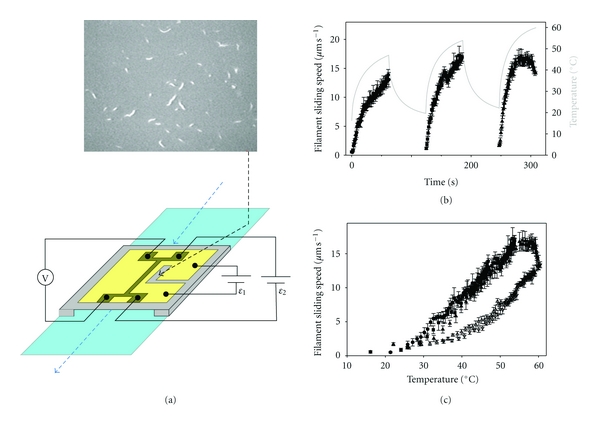Figure 1.

Temperature dependence of HMM-driven sliding of RhPh-labeled actin filaments determined using a microfabricated thermoelectric heater. (a) Modified flow cells were constructed as described [5]. Flow cells consisted of a microscope slide (light blue) and a modified cover slip (gray and gold), separated by two, thin spacers and held together by nonfluorescent vacuum grease. Solutions (Section 2.2) are pipetted through the flow cell as indicated by the blue, dashed arrows. To warm the flow cell, current is injected via circuit ε1 into a microfabricated thermoelectric heater (gold) on the coverslip's outer surface; flow cells are cooled by circulating chilled water through a copper coil wrapped around the microscope objective. Temperature is monitored via a linear, resistive thermometer (dark gold structure) that was microfabricated on the inner face of the coverslip (i.e., on the same side where actomyosin motility occurred, and opposite to the side with the thermoelectric heater); temperature is obtained from a calibrated voltage readout (V) with bias current set by circuit ε2. Motion of fluorescently labeled filaments on the inner side of the coverslip (top micrograph) is observed and recorded through a window (black, dashed arrow) located immediately adjacent to the thermometer. (b) Time course of temperature (gray line; right ordinate) and sliding speed (solid symbols; left ordinate) for regulated thin filaments (F-actin plus native cTn and α-Tm) at pCa 5 during the heating phase of three cycles of heating and cooling (Section 2). Points represent mean ± S.D. of the sliding speed for 3–8 filaments during 1 s. Note that the upper limit of the temperature-dependent increase in sliding speed occurs at ∼54°C (t > 4.5 min). (c) The data from (b) were replotted to eliminate time: cycle 1 (⬤), cycle 2 (■), and cycle 3 (▲). An additional dataset for unregulated F-actin sliding is shown: cycle 1 (▵) and cycle 2 (▿). Note that the sliding speed of regulated thin filaments at the highest temperature is almost the same as for unregulated F-actin.
